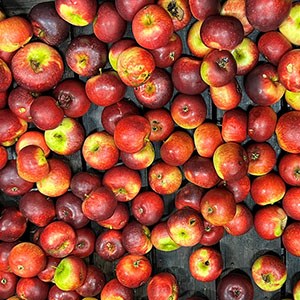Facts:
Research project: Key microbial odorants for innovative codling moth control

Large quantities of apples from both private gardens and industrial production are discarded as waste. By adapting storage methods and by optimising the time of harvest however, the amount of waste could be reduced.
Harvested fruit is sorted into different product classes depending on fruit quality. Classes one and two both denote edible fruit, but class one fruit must not show any cosmetic or visual defects. Class two fruit sells for a lower price and thus gives farmers a lower income. A survey done by SLU showed that 22 percent of apples are classed as industrial fruit which reaches stores in the form of juice and similar products.
– Only rarely do we see class two fruit on sale in stores. And while it is positive to see industrial fruit used in the production of juice, the process yields large amounts of waste product that we currently have no way of utilising, says SLU researcher Marie Olsson.
One way to reduce damage to apples after they have been harvested is to store them under specially adapted conditions. Today, a large share of Swedish apples are stored in so called ULO-storage, which maintain very low oxygen levels as well as temperatures between one and two degrees Celsius.
– I would say that it’s a well-established method which most farmers have access to, to a greater or lesser extent, says Äppelriket CEO Henrik Stridh.
Low oxygen levels is a balance act however, since the fruit can lose its taste if stored at levels that are too low. To find out which oxygen levels are suitable for different varieties of apples, SLU is working with Äppelriket to test so-called dynamic controlled atmosphere (DCA) storage.
– This method is seeing an increased usage in large parts of the world, says Marie Olssson.
At SLU, externally employed doctoral student Joakim Sjöstrand is working to find the optimal time in the growth cycle to harvest apples. Previous methods of determining this has been based on visual inspections of the colour of apples as well as the number of days since efflorescence. Both of these parameters can vary considerably based on the amount of sunlight as well as the temperature during a given season however.
– If we can pinpoint this with greater accuracy we can improve storage longevity, says Marie Olsson.
What makes this project unique is that the optimal date of harvest is calculated based on measurements of the rate of chlorophyll degradation, which is then compared with the traditional methods.
Also of interest to the research at SLU is the pests that target apple trees, such as the codling moth. With the codling moth as a model subject, researchers are studying the ways in which insects are attracted to different scents. This knowledge could be used to develop new and sustainable methods of combating pests.
Research project: Key microbial odorants for innovative codling moth control
More articles on apples: slu.se/apple